

Two Leopard Gecko Vivariums. This guide is intended to show you how to make two vivariums , one 3 foot (914mm) and the other 2.5 foot (762mm), from 1 piece of 8 foot (2438.40mm) x 4 foot (1219.2mm) x 5/8 of an inch (15mm) board.
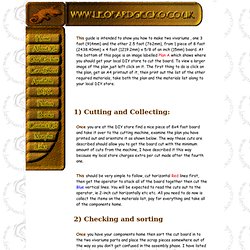
At the bottom of this page is an image labelled Plan A which shows where you should get your local DIY store to cut the board. To view a larger image of the plan just left click on it. The first thing to do is click on the plan, get an A4 printout of it, then print out the list of the other required materials, take both the plan and the materials list along to your local DIY store. 1) Cutting and Collecting: Once you are at the DIY store find a nice piece of 8x4 foot board and take it over to the cutting machine, examine the plan you have printed out and orientate it as shown below.
This should be very simple to follow, cut horizontal Red lines first, then get the operator to stack all of the board together then cut the Blue vertical lines. 2) Checking and sorting 3) Pre assembly. Leopard Geckos Food and Diet. Diet The diet and dietary supplements of your leopard gecko are very important in order to maintain their health.
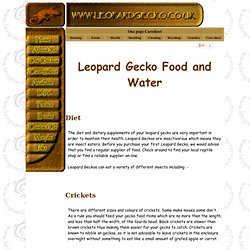
Leopard Geckos are insectivorous which means they are insect eaters. Before you purchase your first Leopard Gecko, we would advise that you find a regular supplier of food. Check around to find your local reptile shop or find a reliable supplier on-line. Leopard Geckos can eat a variety of different insects including: - Crickets There are different sizes and colours of crickets. Mealworms Mealworms were the breeder's choice for a staple diet before crickets became widely available. Locusts We like to vary our geckos diet and locusts of the appropriate size can offer a high protein package. Waxworms You should not feed waxworms as a staple diet as they have a high fat content and can prove addictive. Silkworms Silkworms are sometimes difficult to get hold of but if you can they are a very good source of proteins, vitamins and minerals. How often? Supplements Clean Water. Leopard gecko care sheet.
Leopard Geckos in the wild originate from Pakistan, Afghanistan and northwestern India.
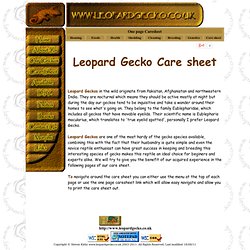
They are nocturnal which means they should be active mostly at night but during the day our geckos tend to be inquisitive and take a wander around their homes to see what's going on. They belong to the family Eublepharidae, which includes all geckos that have movable eyelids. Their scientific name is Eublepharis macularius, which translates to 'true eyelid spotted', personally I prefer Leopard Gecko. Leopard Geckos are one of the most hardy of the gecko species available, combining this with the fact that their husbandry is quite simple and even the novice reptile enthusiast can have great success in keeping and breeding this interesting species of gecko makes this reptile an ideal choice for beginers and experts alike.
We will try to give you the benefit of our acquired experience in the following pages of our care sheet. Leopard Gecko Fact Sheet. Leopard Gecko Taxonomy Order: Squamata Family: Gekkonidae Genus/species: Eublepharis macularius Description Overall the leopard gecko reaches a length of about ten inches (25.4 cm), and gets its name from the leopard-like spots that cover the bodies of adult animals.
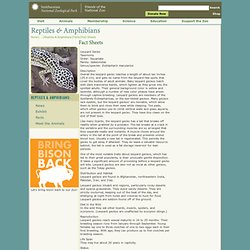
Baby leopard geckos hatch with dark transverse bands, which lighten as they grow into the spotted adults. Their general background color is yellow and lavender, although a number of new color phases have arisen through captive breeding. Leopard geckos are members of the Subfamily Eublepharinae, or the eye-lidded geckos. Like many lizards, the leopard gecko has a tail that breaks off readily when grabbed by a predator. One of the most notable traits about leopard geckos, which has led to their great popularity, is their unusually gentle disposition. Distribution and Habitat Leopard geckos are found in Afghanistan, northwestern India, Pakistan, Iran, and Iraq. Life Span They may live about 20 years in captivity. Pet Leopard Gecko Facts & Lizard Information. Leopard Gecko Biology. Leopard gecko. The leopard gecko (Eublepharis macularius) is a crepuscular ground-dwelling lizard naturally found in the deserts of Asia and throughout Pakistan, to the northwestern parts of India.
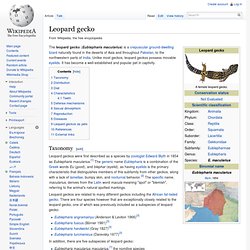
Unlike most geckos, leopard geckos possess movable eyelids. It has become a well-established and popular pet in captivity. Taxonomy[edit] Leopard geckos are related to many different geckos including the African fat-tailed gecko. There are four species however that are exceptionally closely related to the leopard gecko, one of which was previously included as a subspecies of leopard gecko: In addition, there are five subspecies of leopard gecko: Distribution[edit] The native habitat of the leopard gecko is the rocky, dry grassland and desert regions of south-Asian Afghanistan, Pakistan, north-west India, and some parts of Iran.
Diet[edit] Characteristics[edit]